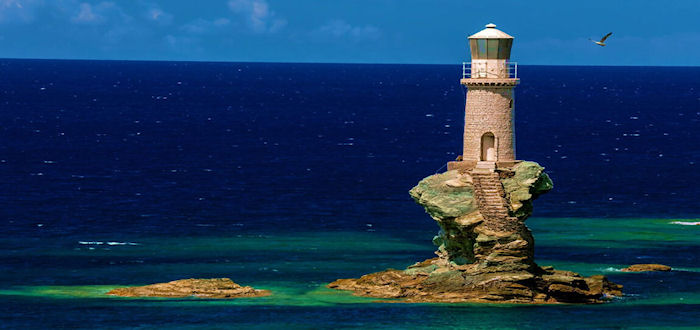One of the most important and up to date monuments that stands at as a characteristic of Greece and the notable position Greece had from the beginning of World Naval history is fading out due to wear and tear and abandonment.
The Lighthouse network of Greece has 120 Traditional lighthouses today, which are approximately two centuries old. Only 20 of them are in very good condition, where as 30 are in medium condition, and the marks of wear and tear are visible to the naked eye in the other structures.
In 1988, Greek Hydrographic and Lighthouses Services that belongs to the Naval Head Quarters (ΓΕΝ) which has the responsibility of the network's management, initiated a total conservation and restoration program for all lighthouses and in addition propelled this plan to be supported by the 2nd Community Support Department.
The Ministry of Culture and the Services of historical monuments took the responsibility to inspect and evaluate the lighthouses one by one. Twenty of them have been visited and have been considered as historical monuments with the need to be conserved. Nevertheless the plan has not been funded and the renovation remained aside.
The Services of lighthouses has the financial ability to repair 3 to 4 structures annually. But with such rate the plan will be completed 40 years of time.
EU funding has revived the hopes to those people who are occupied with the conservation of those historical monuments. Their persistence has obtained a financial support of 1,5 billion drachmas (approximately 4,5 million EURO) in order to initiate a pilot program of the network's restoration.
With these funds the Services of the Naval Headquarters (ΓΕΝ) can repair approximately 40 Lighthouses due to the fact that they offer the knowledge, specialized mechanics and architects.
Destruction
The largest destruction to the Greek lighthouse network occurred during the 2nd World War and specifically during the German Armed Forces retreat from Greece. In 1940, there were 206 store lighthouses, but at the end of the War only 19 remained functional. The first attempt of restoration of the network was made in 1945, and continued till the mid 50s. Approximately 80 lighthouses were rebuilt, the rest were left to their own demise. Light beacons took their place. They were much more cheaper, easier to be placed and maintained. Due to these facts 1.188 of light beacons are used in all the important Ocean areas.

International Cooperation
The development of telecommunications and especially Statelite communications was the final blow to the lighthouse monuments. Until 1980 the Service of Lighthouse network occupied 320 lighthouse keepers, who took care of the conservation and the damages of the structures. The number of lighthouse keepers was reducing slowly and today there are not more than 70.
In the beginning of summer 2001 the Lighthouses Service of the Greek Navy hosted a convention for the International Association of Lighthouse Authorities (IALA) in the island of Spetses, in order to discuss about the alternative uses of the lighthouse network. Greece is the founding member of the Organization and participates in all its activities from 1970. The problem of the lighthouse network conservation concerns all countries and since 1996 there are 3 work groups who are occupied with the registration and the description of the lighthouses condition.
In addition the groups work out the common initiative for their preservation and how to make the lighthouses useful.
A common idea is to convert the lighthouses into museums. From the Lighthouses Service an alternative plan has been considered. This plan indicated the fact to selfund the conservation program with a lighthouse tax. The Annual earnings from the taxes will be 1 billion drs (3 million EURO) which will be rended to the Department of Finance. The Ministry of Marine Affairs studied the proposal of the tax increase as well as its return to the Lighthouse Department, so as to deal with the problems of the Greek Lighthouse network.
Apart from the pilot program, the Lighthouse service initiated an ambitious plan in order to attract visitors. In the year 2000 for the first time 50 members of the Navy spent a part of their vacation in the lighthouses. They made a list of their observations in order to adapt this program for people who are interested to visit and stay a few days in the lighthouses. From last year till today 3 boy scout excursions were also organized and had positive results. Next year these kind of excursions will be more organized and systematic.
All in all, in the island of IOS the lighthouse was restored and remains open to the public with the initiative of the local authorities. Likewise, there was another initiative of the Municipality of GITHIO for the KRANEAS lighthouse which lighthouse will be repaired in cooperation with the Greek National Tourism Organizationin order to host the Naval Museum of MANIS.




